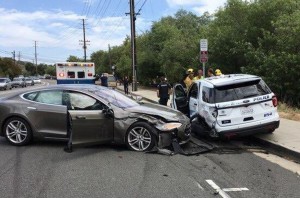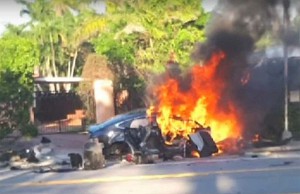
The driver of the Tesla involved in this March crash in Utah suffered a broken foot and other injuries
A Utah woman who was injured in the crash of a Tesla Model S in May has filed a lawsuit against the automaker alleging negligence and claiming that the vehicle’s Autopilot system should have prevented the crash – even though she admitted to police that she was looking at her cellphone when the battery-sedan ran into the back of a fire truck.
Heather Lommatzsch broke her foot in a crash, which occurred about the same time as several other high-profile incidents involving Tesla vehicles using the automaker’s semi-autonomous Autopilot technology. That included one in California in which a motorist was killed when his vehicle hit the center barrier on a freeway and ultimately caught fire.
The lawsuit comes at a particularly awkward time for Tesla, the automaker watching its share price plunge by nearly a third since shortly after CEO Elon Musk announced his interest in taking the company private. That project has since been abandoned and both Musk and Tesla now face an investigation by the SEC. Tesla also faces a number of lawsuits and Autopilot is under investigations by federal regulators following several of those recent crashes.
(Musk lights up – and shareholders are turned off. Click Here for more on the latest flap surrounding CEO Musk.)
According to the document filed by Lommatzsch’s attorneys, the woman “understood” that Autopilot had extensive “safety features (which) would ensure the vehicle would stop on its own in the event of an obstacle being present in the path of the Tesla Model S.”
Instead, her Model S drove straight into the fire truck, the lawsuit claims, and “did not brake or take any action to avoid the collision.”
Her most immediate injury was a broken foot, but the lawsuit says among her other “serious physical injuries” Lommatszch has suffered the loss of “the pleasures and enjoyment of life and physical impairment.”
The Utah woman may face an uphill battle in that immediately after the May 2018 accident she told officers from the South Jordan, Utah police that she “was looking at her phone prior to the collision.” A final report by investigating officers concluded the driver “did not brake or take any action to avoid the collision.” And Lommatzsch was subsequently given a ticket for her “failure to keep proper lookout.”
The incident raises questions both about the capabilities of Tesla’s Autopilot and how it has presented the technology to the public. According to a spokesman for the automaker, “Autopilot doesn’t make the car impervious to all accidents.” After the crash, Tesla pointed out that its website clearly states a driver must remain in a position to retake control in an emergency and always keep hands on the wheel.
However, critics have also pointed out that Tesla, early on, claimed that government data showed Autopilot capable of reducing the number of crashes by “as much as 40%.” That claim has been widely disputed.
(Click Here for more about the impact of Musk’s behavior on Tesla.)
CEO Musk, meanwhile, has frequently touted the capabilities of the technology and, shortly after Autopilot was released, he and his former wife were photographed demonstrating its capabilities by having their hands out the window of a Model S.
Autopilot has been linked to a number of crashes and at least two fatalities, including one in 2016 in which a former Navy SEAL was killed in Florida. He failed to monitor the vehicle and take control when a truck turned in front of his Model S. Two federal safety investigations generated mixed results, though Autopilot was given at least partial blame for failing to recognize the white truck against a bright Florida sky.
Later that year, Tesla made major changes to the Autopilot system, both on the hardware and software sides.
The National Transportation Safety Board is still investigating the March crash in California but preliminary evidence shows that the driver failed to retake control of his Model X despite repeated warnings from the vehicle.
While Tesla, and Musk in particular, have been more cautious in describing the capabilities – and limits – of Autopilot, the South African-born CEO has continued to promote his goal of delivering a fully hands-free version. Many Tesla followers believe that could be announced in a matter of months.
Tesla isn’t the only company to have trouble with autonomous and semi-autonomous technologies. A hands-free Uber prototype was involved in a fatal crash in March in Tempe, Arizona, the back-up operator subsequently blamed for watching a video and failing to take control when the vehicle’s system didn’t spot the pedestrian it subsequently struck.
(To see more about safety groups wanting Tesla Autopilot name banned, Click Here.)
Waymo has had a number of collisions, almost all minor, though in virtually all instances the other vehicle, operated by a human driver, was blamed. That was also the case with the first known collision involving an Apple car prototype.



“A Utah woman … has filed a lawsuit…” Take a number and get in line. Makes me wonder if Tesla’s legal team constitutes a separate corporate division by now.